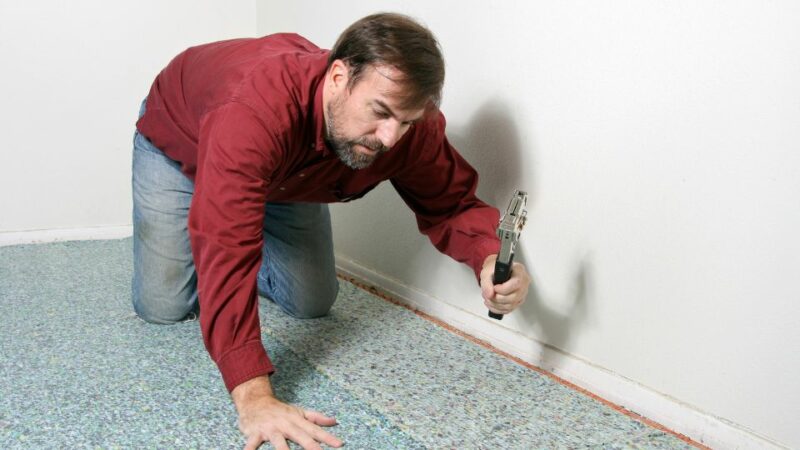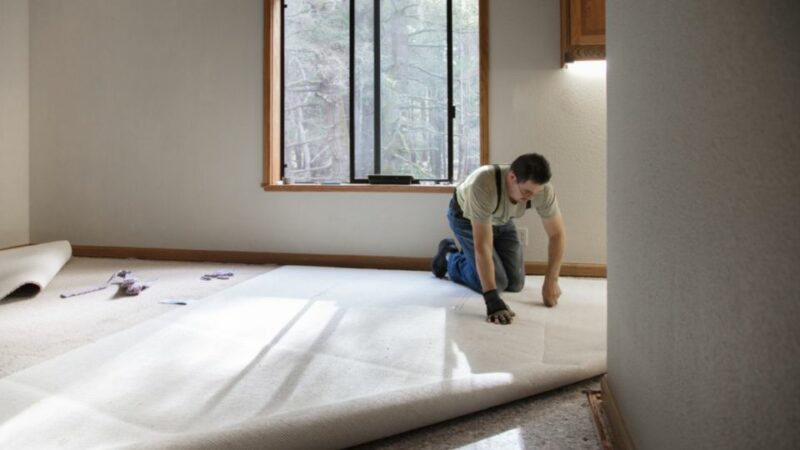Are you looking for the perfect rug or carpet to spruce up your home or office? If so, don’t forget about the importance of carpet padding! Old Hill Carpet Padding is here to provide you with the highest quality and most durable padding available. With a wide variety of options from budget-friendly to luxurious choices, we have the perfect carpet padding for your needs. Read on to learn more about the benefits of Old Hill Carpet Padding and how it can enhance the look and feel of any space.

Any Idea about Carpet Padding?
Carpet padding, also known as the carpet cushion or rug pad, is a dense material that is placed under carpets to provide additional cushioning and support. It is typically made from a variety of materials such as foam, rubber, or felt and is designed to improve the overall comfort and durability of the carpet.
The main function of carpet padding is to provide a soft, cushioned surface for walking, standing, and sitting on. It acts as a shock absorber, reducing the impact on the carpet fibers and prolonging the life of the carpet. Carpet padding also helps to keep the carpet in place, reducing the risk of bunching or sliding.
In addition to its practical uses, carpet padding also improves the overall look and feel of the carpet. It adds a plushness and springiness to the carpet, making it feel more comfortable and luxurious underfoot. It also helps to reduce the amount of wear and tear on the carpet, helping to keep it looking new for longer.
Importance of Carpet Padding
Carpet padding is an essential component of a carpeted floor, as it plays a vital role in the overall comfort, durability, and longevity of the carpet. The following are some of the key benefits and importance of using carpet padding:
- Comfort: Carpet padding provides a soft, cushioned surface for walking, standing, and sitting on. It adds a plushness and springiness to the carpet, making it feel more comfortable underfoot and reducing the impact on the joints.
- Durability: Carpet padding acts as a shock absorber, reducing the impact on the carpet fibers and prolonging the life of the carpet. It also helps to keep the carpet in place, reducing the risk of bunching or sliding, which can cause the carpet to wear out more quickly.
- Insulation: Carpet padding helps to insulate the room by trapping air between the carpet and the floor. This can help to keep the room warm in the winter and cool in the summer, saving on energy costs.
- Sound absorption: Carpet padding can help to reduce the amount of sound that is transmitted through the floor. This can make a room quieter and more comfortable, especially in high-traffic areas.
- Safety: Carpet padding can help to prevent slips and falls by providing a non-slip surface for the carpet to lay on. This is especially important in areas with high foot traffic or in homes with young children or seniors.
- Easy to maintain: Carpet padding is relatively easy to maintain. It can be vacuumed and spot cleaned as needed to keep it looking new.
Carpet padding is an essential component of a carpeted floor, as it plays a vital role in the overall comfort, durability, and longevity of the carpet. It helps to keep the room warm, quiet, and safe, and also prolongs the life of the carpet. It’s important to choose the right type of padding that suits your carpet and room usage, to ensure you are getting the most out of your carpet.
How Carpet Padding Affects the Durability of Carpets
Carpet padding plays a significant role in affecting the durability of carpets. The following are some ways in which carpet padding affects the durability of carpets:
- Shock Absorption: Carpet padding acts as a cushion between the carpet fibers and the hard surface of the floor. This helps to absorb impact and reduce the amount of wear and tear on the carpet fibers. This means that the carpet will last longer, and will need to be replaced less frequently.
- Protection from Moisture: Carpet padding acts as a barrier between the carpet and the floor, protecting the carpet from moisture and mildew. This is especially important in areas that are prone to spills or high humidity. Carpet padding can also help to reduce the amount of water that is absorbed by the carpet, preventing mold and mildew growth.
- Reduced Slipping and Bunching: Carpet padding helps to keep the carpet in place, reducing the risk of bunching or sliding. This means that the carpet will not wear out as quickly, and it will be less likely to require repairs.
- Improved Insulation: Carpet padding helps to insulate the room by trapping air between the carpet and the floor. This can help to keep the room warm in the winter and cool in the summer, saving on energy costs.
- Improved Sound Absorption: Carpet padding can help to reduce the amount of sound that is transmitted through the floor. This can make a room quieter and more comfortable, especially in high-traffic areas.
Carpet padding is an essential component of a carpeted floor, as it plays a vital role in the overall durability and longevity of the carpet. It helps to absorb impact, protect from moisture, prevent slipping, improve insulation and reduce sound transmission. Choosing the right type of padding that suits your carpet and room usage, can greatly enhance the durability of your carpet.
“I would highly recommend their services to anyone in need of carpet padding service!”
– Ben A., Old Hill
Types of Carpet Padding
Carpet padding, also known as the carpet cushion or rug pad, is a dense material that is placed under carpets to provide additional cushioning and support.
| Type of Padding | Pros | Cons | Durability |
|---|---|---|---|
| Foam padding | Affordable, lightweight | Not as durable as other types | Good |
| Waffle rubber padding | Durable, slip-resistant | Expensive | Excellent |
| Felt padding | Good insulation and sound absorption | Not as durable as other types | Fair |
| Fiber padding | Easy to install, Affordable | Not as durable as other types | Fair |
| Memory foam padding | Comfortable, good insulation | Expensive | Excellent |
| Cork padding | Eco-friendly, good insulation | Expensive | Good |
| Jute padding | Eco-friendly, durable | Not as comfortable as other types | Excellent |
| Polyurethane padding | Durable, good insulation | Expensive | Excellent |
| Natural rubber padding | Durable, slip-resistant | Expensive | Excellent |
There are many types of carpet padding available, each with its own unique set of pros and cons. Choosing the right type of padding for your carpet and room usage is crucial to ensure that your carpet is properly supported and protected.
Choosing the Right Carpet Padding for Your Home
Choosing the right type of carpet padding for your home is crucial to ensure that your carpet is properly supported and protected. The following are some factors to consider when selecting carpet padding:
- Type of Carpet: Different types of carpets require different types of padding. For example, a low-pile carpet requires denser padding than a high-pile carpet. Consult with a professional or refer to the carpet manufacturer’s recommendations for the best type of padding for your carpet.
- Room Usage: Different rooms in your home may require different types of padding. For example, a bedroom may require softer padding for comfort, while a high-traffic area such as a hallway may require denser padding for durability.
- Thickness and Density: Carpet padding comes in a range of thicknesses and densities. Thinner padding may be suitable for low-pile carpets, while thicker padding may be needed for high-pile carpets. Denser padding may be more durable, but less comfortable underfoot.
- Insulation and Sound Absorption: Consider the insulation and sound absorption properties of the padding. Good insulation can help to keep the room warm in the winter and cool in the summer, while good sound absorption can make a room quieter.
- Slip-Resistance: A slip-resistant padding is especially important in areas with high foot traffic or in homes with young children or seniors.
- Durability: The durability of the padding is an important factor to consider. Denser and thicker padding may be more durable, but it also tends to be more expensive.
- Cost: Carpet padding comes in a range of prices, from budget-friendly options to more expensive options. Consider the cost of the padding in relation to the overall budget for your flooring project.
When selecting carpet padding for your home, it’s important to consider the type of carpet, room usage, thickness and density, insulation and sound absorption properties, slip resistance, durability, and cost. With the right color correction from Old Hill Carpet Padding, you can make sure that your space is stylish and comfortable while lasting for years to come. Visit Old Hill Carpet Padding today to find the perfect padding for your needs.
How to Maintain and Replace Carpet Padding in Old Hill homes
Maintaining and replacing carpet padding in Old Hill homes is important to ensure that the carpet is properly supported and protected. The following are some tips for maintaining and replacing carpet padding:
- Regular Vacuuming: Regularly vacuuming the carpet and padding can help to remove dirt and debris that can damage the carpet and padding over time.
- Spot Cleaning: If spills or stains occur on the carpet, it’s important to clean them up as quickly as possible to prevent them from soaking into the padding.
- Rotating Furniture: Moving furniture around on a regular basis can help to distribute wear and tear more evenly across the carpet and padding.
- Inspecting Padding: Inspect the padding regularly for any signs of wear or damage. If the padding is visibly worn or flattened, it’s time to replace it.
- Replacing Padding: When it’s time to replace the padding, it’s important to remove the old padding and install new padding. This should be done by a professional or a person with proper knowledge and experience.
- Choosing the Right Padding: When replacing the padding, it’s important to choose the right type of padding that suits your carpet and room usage.
- Proper Installation: Proper installation of the new padding is essential to ensure that the carpet is properly supported and protected.
Maintaining and replacing carpet padding in Old Hill homes is important to ensure that the carpet is properly supported and protected. Regular vacuuming, spot cleaning, rotating furniture, inspecting the padding, replacing worn or damaged padding, choosing the right padding, and proper installation are all important steps in maintaining and replacing carpet padding. It is recommended to consult with a professional or refer to the carpet manufacturer’s recommendations for the best way to maintain and replace your carpet padding.
In conclusion, carpet padding is an essential component of a carpeted floor. It not only provides additional cushioning and support, but it also helps to extend the life of the carpet. Without proper padding, the carpet may wear out more quickly, lose its shape, and become less comfortable underfoot.
When selecting carpet padding for a home in Old Hill, it is important to consider the type of carpet, room usage, thickness and density, insulation and sound absorption, slip resistance, durability, and cost. By considering these factors, homeowners can ensure that they are choosing the right type of padding for their needs.
Proper maintenance and replacement of the carpet padding are also important to ensure that the carpet is properly supported and protected. Regular vacuuming, spot cleaning, rotating furniture, inspecting the padding, replacing worn or damaged padding, choosing the right padding, and proper installation are all important steps in maintaining and replacing carpet padding.
Our latest work









